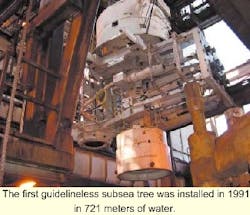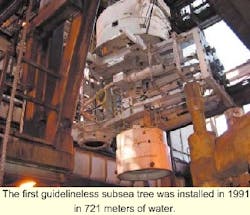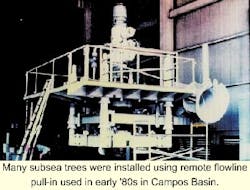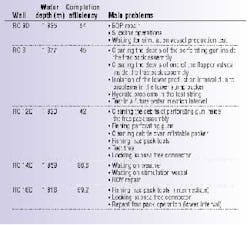SUBSEA TECHNOLOGY: Despite accident, Roncador pushing evolution of ultra-deep completions
Many of the technologies used on the Roncador Field pushed forward many subsea developments being planned for ultra-deepwater, such as subsea trees, completion risers, steel catenary risers, flexible risers (10 in.) for 1,500 meter depths, flowlines to 2,000 meter water depths, and mooring of floating production units in great water depths.
Roncador, discovered in 1996 by the wildcat well 1 RJS 436 A, is located in 1,853 meters water depth. The size of the field (132 sq km), the good quality of the crude (31° API) with the concurrent benefits for the downstream, together with economic results, led Petrobras to adopt a fasttracking development plan. With in-house expertise in completions based on the Marlim and Marlim Sul fields, the subsea completions were designed to produce to floating producers (FPU).
This kind of development was technically feasible and would also bring about earlier cash flow. But this solution was not as simple as previous projects, and Roncador became the most challenging project involving several multi-disciplinary teams. The field development was planned to be modular, including a pilot system, followed by Phases 1, 2 East, and 2 West.
Phase 1 comprised the use of the semisubmersible P-36 as an FPU moored at 1,360 meters water depth, and a floating storage and offloading unit (FSO), the P-47, anchored by a turret system at 815 meters water depth, and subsea trees connected directly to the P-36.
The pilot system and Phase 1 of the development plan were launched at the same time. While the FPU and FSO were being converted, the pilot system was installed in the wildcat well 1 RJS 436 A, with the use of the Seillean, a dynamically positioning (DP) floating produc-tion, storage, and offloading (FPSO) unit. Using a subsea tree installed at 1,853 meters water depth, production was directed through a rigid riser directly to the FPSO. First oil was produced 27 months after the field discovery.
The pilot system successfully operated from January 25, 1999, to January 3, 2001, when it was demobilized. The idea was to produce the well initially to the Seillean and later transfer it to the P-36. So, the well was completed with two frac-pack sets of perforations, a 5.5-in. production string with a permanent downhole gauge (PDG), and gaslift mandrels, by a dynamically positioning drilling semisubmersible. Then, the well was abandoned after the tubing hanger installation, so the subsea tree could be installed by the Seillean.
Roncador Phase 1
The Roncador Phase 1 development was challenging, not only for having the deepest subsea well installation in the world, at 1,877 meters (well now shut-in due to the P-36 accident), but because other records for offshore development were set: use of slender wells, horizontal wells, horizontal trees, and subsea manifolds for gaslift optimization (not installed yet) in ultra-deepwater.
Phase 1 comprised 21 production wells and 5 water-injection wells located around 10 km from where the production platform (P-36) was located. Development started in 1999 and the first oil was produced in June 2000 by the well RO 9D-RO 8. A second producer, at 1,877 meters water depth, was next onstream. Many DP drillships and semisubmersibles were used simultaneously to drill and complete wells.
The oil was produced to the P-36, which had a processing capacity of 180,000 b/d. After processing and treatment, the oil was exported to the P-47 via a turret, and offloaded via shuttle tankers. The gas was pumped through a 10/20 in. pipeline to an existing platform and then to shore.
The DP rigs have worked in close proximity to the Seillean and the offloading DP tanker, and detailed studies have been planned to prevent acoustic interference among the several DP systems. Recently, studies were conducted to determine a safe area around each rig to prevent collisions in the event of a DP blackout. Contingency plans for the drilling/completion rigs were also written if problems occurred with the FPSO Seillean or the DP tanker during offloading.
Drilling
Initial drilling projects involved the use of a jetted 30-in. conductor pipe, followed by a 20-in. casing string with a 163/4-in. by 10,000 psi wellhead housing. Subsequent phases used a 133/8-in. casing string and a 95/8-in. production casing. The wells RO 8 (vertical) and RO 9D (maximum deviation 34 degrees) were drilled with this casing design, and the drilling operations lasted 62 and 61 days, respectively.
With better field knowledge, slender well technology, widely used on the Marlim field, was also introduced in Roncador, decreasing the drilling time of the deviated wells to 35 to 40 days. With this technology, the well was spudded with a jetted 30 in. conductor pipe, followed by a 133/8-in. casing with a 163/4-in. by 10,000 psi wellhead housing. After total depth was reached, the 95/8-in. casing was run, saving the cost of running and cementing the 20 in. casing. Horizontal wellbore technology also was used in the RO 19HA well, which was drilled in 1,537 meters water depth, with 450 meters of horizontal section. The well was completed with a horizontal tree.
Completions
The directional and vertical wells on Roncador were perforated with 7-in. wireline conveyed guns and frac-packed for sand control. The frac-packs proved to be very effective since they increased the productivity index. Conventional frac-packs and selective frac-pack systems were used.
Upon installation of the sand control system, the wells were temporarily abandoned to allow installation of the tubing spool. Later on, 51/2- or 7-in. production strings, with gas lift mandrels and PDG, were installed. In the first three subsea completions on Roncador (RO 9D, RO 8 and RO 12D), cleaning and testing of the frac-packed intervals was performed prior to the installation of the production string. This sequence of events brought about problems related to hydrates.
Hydrates were formed inside either the 5-in. drill pipe or the 51/2-in. buttress pipe strings during the formation cleaning process. This occurred in water depths of 600-1,600 meters (above the subsea test tree and the blowout preventer), causing difficulty in running slickline tools and gauges to perform production tests. These problems led to changes in the completion programs.
The next completions on Roncador (RO 14 and RO 16D) broke an important paradigm, when compared to the initial completions. The well intervals were flowed and tested only after the installation of the subsea tree, allowing a longer elapsed time between the frac-pack operation and cleaning the intervals.
The advantages of performing production tests after the subsea tree installation were the elimination of the subsea test tree, shutting-in the well with the subsea tree, decreasing storage effects in the test interpretation, and preventing hydrates with the use of the PDG to monitor pressures and temperatures. This procedure allowed a safer operation because there would not be wire in the subsea tree or downhole, in the event an emergency disconnection took place.
The use of the PDG to perform the tests was only possible because a monobore completion riser, called the drillpipe riser (DPR), was used to install the subsea tree. As it is a multiplexed system, it was possible to install this interface. Prior to the unlatching of the subsea tree installation tool, a remotely operated vehicle disconnects the electrical cable hooked up to the subsea tree. All TH and subsea tree installations were accomplished with the DPR, which proved to be reliable and time-saving.
The subsea trees used in Roncador are basically the same as those used in other deepwater fields, with the exception of the tubing spool. The subsea layout on Roncador introduced another innovation in the layouts usually practiced in Campos Basin. There are seven in. OD production and 51/2-in. OD annulus rigid flowlines, with flexible jumpers in the tree and flexible risers to connect the wells RO 12D, RO 14, and RO 16D to P-36, used in place of traditional flexible flowlines. Since all completions in the vertical and directional wells are similar, some main observations of the efficiency of the completions were made:
- Overall completion efficiency has reached the same performance level experienced in shallower waters.
- Much time was lost due to perforating gun debris. Usually, this is not a problem in standard operations, because the debris falls to the bottom and there is no need to retrieve anything from the wellbore. On Roncador, as multi-frac-packs were conducted, the gun debris fell on the flapper valves used in the gravel assembly, creating several problems. The problem was solved by use of low debris perforating guns; one service company supplies low debris perforating guns to suit wellsite needs.
- Although better performance of the selective frac-pack tools has been verified, when compared to conventional frac-pack methods, it should be pointed out that there is still room for improvement.
- There were no problems associated with tubing hanger installation, which was a critical operation in shallower waters where the tubing hanger was installed directly in the wellhead and not in a tubing spool.
- There was no time lost with the DPR, which confirmed its operational capability when running either the TH or subsea trees in ultra-deepwater. Moreover, there was time saving in the operations with the DPR, compared to conventional dual-bore completion risers.
- The problems with the tree connector involved two different manufacturers. One problem was caused by interface between the tree connector hydraulic system and the DPR multiplexed system. The second problem was interference between the tree connector and the tubing spool.
Future of completions
Exploratory drilling is being performed in water depths of 2,500-3,000 meters in the Campos Basin. In the near future, fields in this water depth will be brought onstream. The most attractive completion and development solution is to use subsea completions producing to FPUs. Today, hardware such as the horizontal subsea tree installed on the RO 19HA well and the associated completion risers are being developed to produce wells with subsea completions in 2,500 meter depths.
The decision to develop only horizontal trees for this water depth range was based on the possibility of installing large bore production strings, aimed at high productivity well situations. Moreover, with proven DPR technology on Roncador, monobore completion risers will be used in deeper water.
The use of subsea completions producing to FPUs has proved to be economically and technically feasible in ultra-deepwater. Fur-ther developments are underway to allow production in 3,000 meters water depth using subsea completions.
Editor's Note: This is an update of OTC 13259, presented in May 2000.



